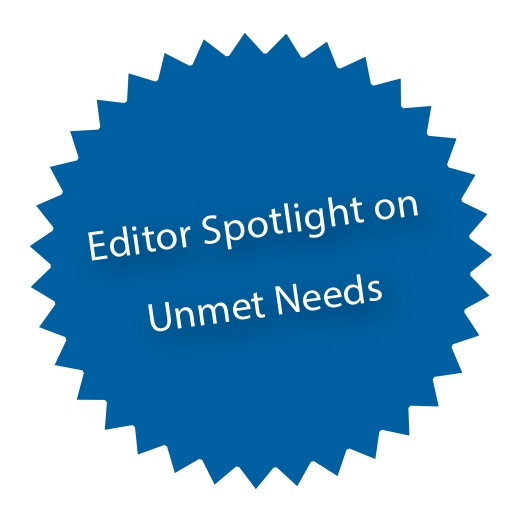In AD, in previous years more and more targeted therapies were emerging. “Once we have more treatment options for a disease, it is really important to start doing head-to-head trials to know the characteristics of a drug,” said Prof. Kristian Reich (University Medical Center Hamburg-Eppendorf, Germany) [1]. The JADE DARE trial was a 26-week, randomised, double-blind, phase 3b trial (NCT04345367) that compared the JAK inhibitor abrocitinib in a high dose to the IL-4/IL-13 blocker dupilumab in the approved dose. Participants were adult patients with moderate-to-severe AD with an inadequate response to topical medication or requirement for systemic therapy to control the disease. The co-primary endpoints were proportion of patients achieving a clinically relevant improvement of peak pruritus of at least 4-points on the 10-point numerical rating scale (PP-NRS4)at week 4?, and proportion of patients achieving an improvement of at least 90% in the Eczema Area and Severity Index (EASI 90) at week 4. Low-potency or medium-potency topical steroids (TCS) applied once daily to areas with active lesions were allowed from day 1.
Baseline characteristics were similar between both groups. At week 2, the PP-NRS4 response rate was significantly higher in the abrocitinib group compared with the dupilumab group (48.2% vs 25.5%; P<0.001). “The longer you wait, the more the 2 curves are overlapping, but the early effect is different,” Prof. Reich explained. After 16 weeks, both dupilumab and abrocitinib showed a similar PP-NRS4 response rate. “If you have a patient that is desperate because of itch and who cannot sleep at night, then a JAK inhibitor appears to be a very meaningful choice,” Prof. Reich commented.
At week 4, the EASI 90 response rate was 28.5% of patients treated with abrocitinib compared with 14.6% with dupilumab (P<0.001). “At week 16, you still see a clinically relevant difference between the 2 treatment modalities,” Prof. Reich said. At week 16, 54.3% of patients treated with abrocitinib and 41.9% of patients treated with dupilumab achieved an EASI 90 response (P<0.001). Later, patients treated with the biologic catch up, and there is no meaningful difference with regard to EASI 90 response and itch.
A few patients had serious treatment-emergent adverse event or events that led to study discontinuation. Nausea, headache, and acne were the most common adverse events reported by patients taking abrocitinib, and conjunctivitis was more frequent in the dupilumab group.
- Reich K. Efficacy and safety of abrocitinib versus dupilumab in adults with moderate-to-severe atopic dermatitis who received background topical therapy in a 26-week, randomized, head-to-head trial. D3T01.2B, EADV Congress 2021, 29 Sept–2 Oct.
Copyright ©2021 Medicom Medical Publishers
Posted on
Previous Article
« AD patients with stable response fare well with a monthly dose of tralokinumab Next Article
Topical JAK1/JAK2 inhibitor effective in vitiligo »
« AD patients with stable response fare well with a monthly dose of tralokinumab Next Article
Topical JAK1/JAK2 inhibitor effective in vitiligo »
Table of Contents: EADV 2021
Featured articles
Letter from the Editor
Long-term disease control in AD could be in reach with anti-OX40 antibody KHK4083
Late-Breaking News
Targeting OX40 in the treatment of atopic dermatitis meets expectations
Superior EASI scores after switch from dupilumab to upadacitinib
CSU: Novel agent targeting Bruton’s tyrosine kinase leads to disease control
Novel JAK3/TEC blocker leads to maintained re-pigmentation in vitiligo
TYK2 inhibitor deucravacitinib shows impressive long-term response in psoriasis
Tapinarof cream for psoriasis leads to high clearance rates and remittive effect
CSU: Ligelizumab likely safe and effective for adolescents
Long-term disease control in AD could be in reach with anti-OX40 antibody KHK4083
Topical JAK1/JAK2 inhibitor effective in vitiligo
Abrocitinib demonstrates fast itch control and skin clearance in atopic dermatitis
AD patients with stable response fare well with a monthly dose of tralokinumab
Opioid receptor agonist difelikefalin disappoints in AD
Atopic Dermatitis: State of the Art
Upadacitinib beats dupilumab in different body regions
Efficacious 2-year AD control with IL-13 inhibitor tralokinumab
Ruxolitinib cream: a safe treatment for elderly AD patients
Novel and upcoming targeted AD treatment
Psoriasis: What's New?
Existing and upcoming small molecules in psoriasis
Treating psoriasis during pregnancies
A patient-related approach to freedom of disease
Ixekizumab superior to secukinumab in real-world psoriasis study
Nail psoriasis: An important target to be treated
Grand debate: Is psoriasis a systemic or skin-only disease?
Spotlight on Alopecia Areata
JAK1/2: A promising novel treatment target in alopecia areata
Alopecia areata: encouraging response rates with JAK3/TEC inhibition
Related Articles

November 18, 2021
JAK1/2: A promising novel treatment target in alopecia areata
November 18, 2021
CSU: Ligelizumab likely safe and effective for adolescents

November 18, 2021
Letter from the Editor
© 2024 Medicom Medical Publishers. All rights reserved. Terms and Conditions | Privacy Policy
HEAD OFFICE
Laarderhoogtweg 25
1101 EB Amsterdam
The Netherlands
T: +31 85 4012 560
E: publishers@medicom-publishers.com

